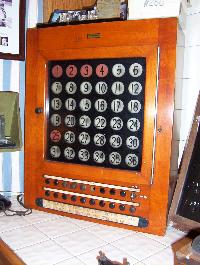 |
This is an interesting Western Electric annunciator panel that I picked up. It is from a telephone central office
and would have been used to monitor various equipment in the CO.
The unit is basically just a box with lights in it, as there is a bulb behind each number, or should
be. There are 4 sockets missing. The box is made of wood, probably oak or walnut. Below the numbers are a handful of
controls. The black spots look like jacks in the photo, but they are hole plugs. There are a couple of push buttons, a pull out "kill" switch
(I think that's what it's for, it's labeled master power), and a turn key to set day or night mode.
The big sign below the controls area says "On red signal start emergency ringing machine, notify chief
switchman or emergency bureau." This would indicate that at least some of the alarm lights (the red ones) monitored
the ringing machines. There is no audible alarm in this panel, like a bell or buzzer, only the lights. |
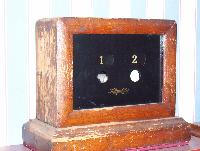 |
There are a pair of these small desktop Holtzer-Cabot annunciators in the collection. These little indicators have round white flags that move to a
visible position when actuated. There is also a buzzer that sounds when a drop is signaled, and the drops reset electrically. These small
annunciators have only two drops each. |
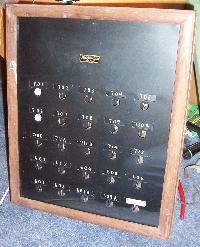 | Here's a big wall-mounted version of the above unit. Also by Holtzer-Cabot, this large annunciator panel
has 25 drops and has the same round white flags. This panel also resets electrically, and has a reset button under the lower edge, not seen in the
photo. A date tag inside the panel shows a 1929 manufacture date, and it operates on 12 volts AC. Indeed, it has an AC buzzer in it and while
the drops will work on DC, the buzzer will only "click" with DC. |
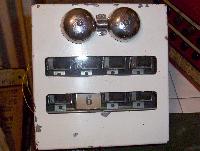 | This is a small 3-volt DC annunciator with rectangular flags that drop into view when actuated -- Number 6 is shown
in the dropped position. The bells on top of the unit ring when any drop is signalled. This
panel's drops are reset with a mechanical push lever on the bottom of the unit.
|
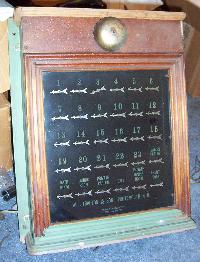 | This is probably the oldest annunciator in the collection, and shows a patent date of 1894. This panel's drops
are arrows, which rotate to an upright position when actuated. The top rows of drops are identified by number, but the drops on the bottom two rows
are identified with such quaint locations as "Ladies Parlor," "Dining Room," "Front Door," and "Private Parlor." It might have been in a hotel. The
drops are reset with a mechanical lever on the bottom of the unit.
|
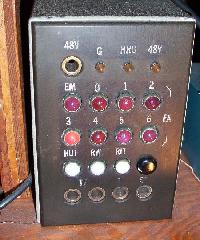 | Here's an item that isn't really an annunciator like the servant call devices, but is an alarm annunciator. It is from
an early Long Distance call recording device, used with a #5 Crossbar switching office. I am told that this box would display the alarm status of up to eight
CAMA paper tape punch machines that would be located in a #5 office. The red indicators would be Fuse Alarm (FA) indications for the eight paper punches, and the
white indicators are for showing other machine status. RUT is for Recorder Under Test, RIT for Recorder In Trouble, and RW for Recorder Waiting. The box also
has test points for -48VDC, ground and high resistance ground. An interesting unit for which I had no idea what it was until I came across a former #5 Crossbar
technician who set me straight! |





